AUCTORES
Globalize your Research
Research Article | DOI: https://doi.org/10.31579/2767-7370/028
1 Genetic Laboratory, Jinhua Maternal & Child Health Care Hospital, Jinhua, 321000, Zhejiang Province, China.
2 Central Laboratory, Affiliated Jinhua Hospital, Zhejiang University School of Medicine, Jinhua, 321000, Zhejiang Province, China.
3 Medical Molecular Biology Laboratory, School of Medicine, Jinhua Polytechnic, Jinhua 321007, China.
4 Jinhua Center of Laboratory Animals, Jinhua Municipal Food and Drug Inspection Institute, Jinhua, 321000, Zhejiang Province, China.
*Corresponding Author: Luo Jianfeng, Central laboratory, Affiliated Jinhua Hospital, Zhejiang University School of Medicine, No. 365 Renmin East Road, Jinhua, 321000, Zhejiang Province, China.
Citation: Jin Keqin, Luo Jianfeng, Su Aifang, Ding Mingxing, Fu Saihong, et al. (2022). Biocompatibility of MSC-Seeded Pelvic Patch. J New Medical Innovations and Research, 3(1); DOI:10.31579/2767-7370/028
Copyright: © 2022, Luo Jianfeng. This is an open access article distributed under the Creative Commons Attribution License, which permits unrestricted use, distribution, and reproduction in any medium, provided the original work is properly cited.
Received: 12 July 2022 | Accepted: 25 July 2022 | Published: 02 August 2022
Keywords: inflammatory response; pelvic patch; SF/COL/PLCL; UC-MSC; FPFD
Objective: To investigate the Biocompatibility of a silk fibroin/collagen/poly (lactide-co-caprolactone) (SF/COL/PLCL) electrospun three-dimensional nanofibre scaffold seeded with human umbilical cord-derived mesenchymal stem cells (UC-MSCs) in rats.
Methods: Twelve adult male Sprague-Dawley rats were randomly divided into two groups of six; the first received a patch seeded with UC-MSCs, whereas the second received a control patch without UC-MSCs. The patches were implanted subcutaneously in the abdomens of rats, and subsequent inflammatory reactions and levels of tissue generation and angiogenesis were monitored over a 12-week period using haematoxylin-eosin and Masson staining, alongside quantitative fluorescence PCR.
Results: The cell viability was strongest when the SF/COL/PLCL patch was seeded with UC-MSCs for up to 7 days, and cells retained normal morphology and structure when viewed under an electron microscope. The implanted patches seeded with UC-MSCs showed better tissue fusion, faster degradation, and higher deposition of collagen fibres and neovascularization than the naked patches for up to 12 weeks, (p<0.01), but there was no significant difference in fibrosis scores between the two groups (p>0.05). By the end of the study, rats receiving the seeded nanofibre implants showed improved inflammation resolution, as reflected by lower IL-6 levels (p<0.01). However, IL-2, IL-8, and TNF-α levels were not significantly different between the two groups (p>0.05).
Conclusion(s): The application of UC-MSCs to SF/COL/PLCL patches has the potential to improve the levels of tissue fusion and reduce inflammation, making it a potential treatment for human pelvic floor reconstruction.
Female pelvic floor dysfunction (FPFD) is a common problem faced by middle-aged and older women, with an estimated burden of morbidity between 30 and 50% [1,2]. This condition can lead to anatomical and structural changes to the reproductive and surrounding organs, resulting in abnormalities in their position and function, and eventually presenting as a pelvic organ prolapse (POP) and stress urinary incontinence. Although the disease does not pose a threat to the life of the patient, it impacts their quality of life and as a consequence, results in a psychological burden.
Pelvic floor reconstruction is an important treatment for FPFD and accounts for 40–60% of general gynaecological surgery. The complexity of the pelvic floor structure and its mechanics, with mean disease recurrence rates up to 19%, can often necessitate the need for reoperation [3]. In recent years, owing to the emergence of new surgical techniques, both synthetic and biomaterial patches have been increasingly used in clinical settings; however, these materials have their own pros and cons [4,5]. Complications of using these patches include vaginal erosion, recurring infections, granuloma, dyspareunia, vesicovaginal fistula, and chronic pain. In July 2011, the Food and Drug Administration issued a second warning on the use of non-absorbable scaffold polypropylene patches in FPFD surgery, based on the potential of these patches to cause infections, graft-versus-host disease, and persistent postoperative pain [6,7]. Patches made from biomaterials reduce several of the complications associated with the use of foreign materials, but their clinical application is limited by poor efficacy; hence, there is a need for better treatment options.
A new approach to treating FPFD is use of a biological substitute composed of seed cells cultured in vitro, along with scaffold materials. These biological substitutes have the ability to repair the damaged parts of human tissue and organs because as the scaffold materials degrade, the seed cells proliferate, differentiate, and form new tissues, facilitating wound repair and ultimately functional reconstruction [8]. The success of biological substitutes depends on two aspects: the choice of seed cells and the scaffold materials used.
Mesenchymal stem cells (MSCs) are multipotent adult stem cells present in multiple tissues, including umbilical cord, bone marrow, and fat tissue; they can self-renew by dividing and can differentiate into multiple tissues [9,10]. Bone marrow mesenchymal stem cells (BMSCs) were among the first MSCs to be characterized and used in the regenerative medicine clinical setting; however, the process of bone marrow extraction is not readily accepted by patients, and this limits their potential application in PFD. In contrast, human umbilical cord-derived mesenchymal stem cells (UC-MSCs) have similar properties to BMSCs, with the added advantage that they can be more easily sourced, have higher amplification capacities, and carry a lower risk of bacterial/viral infections; moreover, the chance of rejection graft-versus-host disease is lower. Previous reports [11] have demonstrated that UC-MSCs can induce tissue-forming cells in mice, confirming their potential to play a role in fascia tissue engineering. Ding et al. recently developed a few candidate nanofibrous materials suitable for pelvic reconstruction, which showed high UC-MSCs adhesion capacity. These developments suggest that UC-MSCs would be an ideal seed cell source for female pelvic floor reconstruction.
In terms of scaffolding, nanocomposite materials offer advantages over simple scaffold materials [12,14], because they can simulate the extracellular matrix microenvironment in ways similar to human tissue. For example, collagen (COL) can directly or indirectly influence the process of cell proliferation, adhesion, and differentiation [15]. Further, poly(L-lactide) can easily be degraded in 30–50 weeks [16] and polyester–polycaprolactone has excellent biocompatibility and mechanical properties [17].
To date, only a few studies have investigated the integration of MSCs and bio-degradable nano-filament membranes and the overall graft-versus-host reaction to them [18,19]; therefore, little is known about how stem cells combined with nano-fibrous materials could improve pelvic floor reconstruction outcomes. Despite ongoing research in the field of cell-based tissue engineering, it is still unclear how the reticular structures of the nanocomposites affect stem/progenitor cells and ultimately long-term tissue integration. In this study, we investigate the Biocompatibility of a silk fibroin/collagen/poly(lactide-co-caprolactone) (SF/COL/PLCL) electrospun three-dimensional nanofibre scaffold seeded with human umbilical cord-derived mesenchymal stem cells (UC-MSCs) in rats. The findings of this study could form the basis of future mesh applications in female pelvic floor reconstruction.
2.1 hUC-MSC transfection with a GFP-carrying lentivirus
The isolated UC-MSCs cells were cultured and amplified in 24-well plates. In total, 3.5×104 cells were added to each well and incubated overnight. The fluid was replaced when the cell coverage rate reached 60%. Virus amounts, corresponding to different MOI values, were added. The medium was changed after 8 hours of viral infection, then cells were cultivated for an additional 48 hours. When the viral particle titre reached 1×108 TU/ml, the cells were collected for subsequent experiments [20].
2.2 Manufacture of electrospun three-dimensional nanofiber scaffold
SF/COL/PLCL electrospun three-dimensional nanofibre scaffolds were manufactured as follows: SF, COL, and PLCL were dissolved in hexafluoroisopropanol solution in the mass ratio of 7:3:10, according to Liu et al [21]. The polymer solution (8%) was electrospun at a voltage of 11 kV, achieving a distance of 12 cm and ejection velocity of 1.5 ml/h. The scaffold was then desiccated in a vacuum drying chamber.
2.3. Detection of the growth and proliferation of UC-MSCs on the nanofibre
The lentivirus-transduced cells were inoculated onto the three-dimensional nanofibre scaffold. Cell morphology was observed by a scanning electron microscope on days 5, 7, and 9 after inoculation. Finally, the CCK8 assay was used to determine the cell proliferation state.
2.4. Implantation of nanofibre scaffolds
Twelve SD rats, purchased at 4 weeks of age, were randomly divided into two groups. After being anesthetised with 10% chloral hydrate (300 mg/kg), the rats were fixed in a supine position and a 1 cm long incision was made in the lateral ventral wall. The SF/COL/PLCL mesh loaded with UC-MSCs was implanted subcutaneously in the abdomen of rats in the experimental group. A simple SF/COL/PLCL mesh was implanted subcutaneously in the abdomen of the rats in the control group. The survival and distribution of the transplanted cells was observed at 1, 4, and 12 weeks post-implantation. The rats were euthanised, and the mesh was retrieved. The inflammatory reaction, tissue generation and angiogenesis, fibre wrapping, and scaffold degradation of the two groups were compared using haematoxylin-eosin and Masson staining. The levels of inflammatory cytokines, specifically IL-2, IL-6, IL-8, and TNF-α, in the tissue surrounding the implanted scaffold were measured using quantitative fluorescence PCR.
2.5. Histopathological observations following implantation
The tissue samples were immediately immobilised in a 4% paraformaldehyde solution and dehydrated with ethanol for paraffin sectioning (4–5 µm). The inflammatory cell infiltration was observed, according to standard haematoxylin and eosin staining, Masson staining was used to detect fibrosis, and CD31 immunohistochemical labelling was used to detect new blood vessels. The tissue samples, collected at the different time points, were examined semi-quantitatively under a light microscope. Individual slides were scored from 0–4 (0: none, 1: minimum, 2: mild, 3: intermediate, 4: severe), in terms of inflammatory cell infiltration, the level of fibration, and angiogenesis [22].
2.6. Quantitative analysis of IL-2, IL-6, IL-8, and TNF-α with qRT-PCR
Total RNA was extracted from cells using TRIzol reagent, according to the manufacturer’s instructions. IL-2, IL-6, IL-8, TNF-α, and β-actin products were amplified by qRT-PCR, using β-actin as the internal reference. The conditions of qRT-PCR amplification were as follows: 95°C for 30 seconds, 95°C for 10 seconds, and then 40 cycles at 60°C for 30 seconds. The specific primer sets used to detect gene mRNA expression are shown in Table 1. The comparative threshold (Ct) method was used to determine the amount of target gene mRNA, by normalising the target mRNA Ct value to the GAPDH value (ΔCt).
Table 1: Specifications of primer sequences used for quantitative real-time PCR
Species | RNA name | Primer type | Primer sequence |
Rat | IL-2 | F | TCCCCATGATGCTCACGTTT |
Rat | IL-2 | R | TCCGAGTTCATTTTCCAGGCA |
Rat | IL-6 | F | AGCGATGATGCACTGTCAGA |
Rat | IL-6 | R | GGAACTCCAGAAGACCAGAGC |
Rat | IL-8 | F | ACTGAGCCCCTCCCTACTAA |
Rat | IL-8 | R | TGTCTTCAATCCATCCCAGAGC |
Rat | TNF-α | F | AAGGAGGAGAAGTTCCCAAATG |
Rat | TNF-α | R | GGGCTACGGGCTTGTCACTC |
Rat | β-actin | F | CCCATCTATGAGGGTTACGC |
Rat | β-actin | R | TTTAATGTCACGCACGATTTC |
Statistical analysis was performed using SPSS 23.0 software (IBM Corp., Armonk, NY, USA). Quantitative data are expressed as the mean ± standard deviation. Between-group comparisons were performed using repeated measures ANOVA followed by Tukey’s honestly significant difference (HSD) test. Qualitative data were expressed as the rate, and within-group comparisons were made using the Chi-squared test. p less than 0.05 was considered to imply statistically significant differences.
4.1. Cell growth and proliferation after nanofibrous scaffold implantation
Lentiviral transduction did not adversely affect cell viability. Cell viability increased significantly after 5 days of inoculation and continued to increase until day 7 but declined from day 9 onwards. The survival rate of the cells at different time periods following implantation showed statistical significance (F=702.85, p less than 0.01; Figure 1).
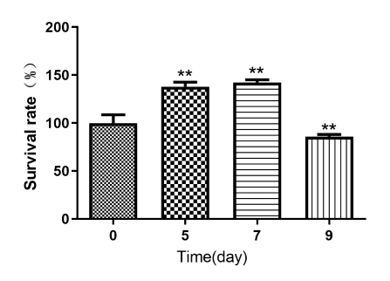
4.2. Cell morphology of lentivirus-transfected UC-MSCs post-implantation on nano-fibrous scaffolds
The cellular morphology was normal on day 7, and the cells showed a normal structure with strong extensions and a significant increase in proliferation ability. By day 9, the cellular proliferation ability had decreased, and the cells showed swelling and structural disconnections (Figure 2).
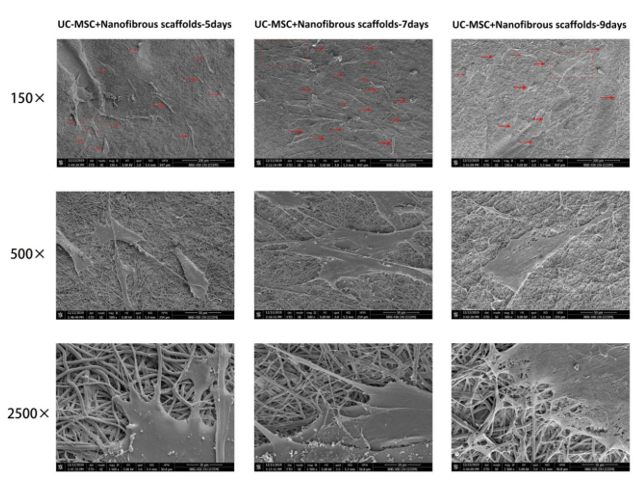
4.3. Histopathology assessment
The H&E staining revealed that the SF/COL/PLCL control group showed a clear scaffold structure at week 1 and 4. The scaffold slowly degraded as time passed, and by week 12, the scaffold’s central area was no longer visible and the surrounding tissues had covered the peripheral area. In the UC-MSC-seeded scaffold group, the nano-fibrous membrane was still intact at week 1, but there had been significant infiltration by inflammatory cells. The scaffold structure was completely disintegrated by week 4, and by week 12, the inflammatory cell infiltration had subsided. The level of inflammatory cell infiltration was significantly different between the control SF/COL/PLCL nano-fibrous membrane and the UC-MSC-seeded nano-fibrous membrane groups (F=23.79, pless than0.01) (Figure 3, 4).
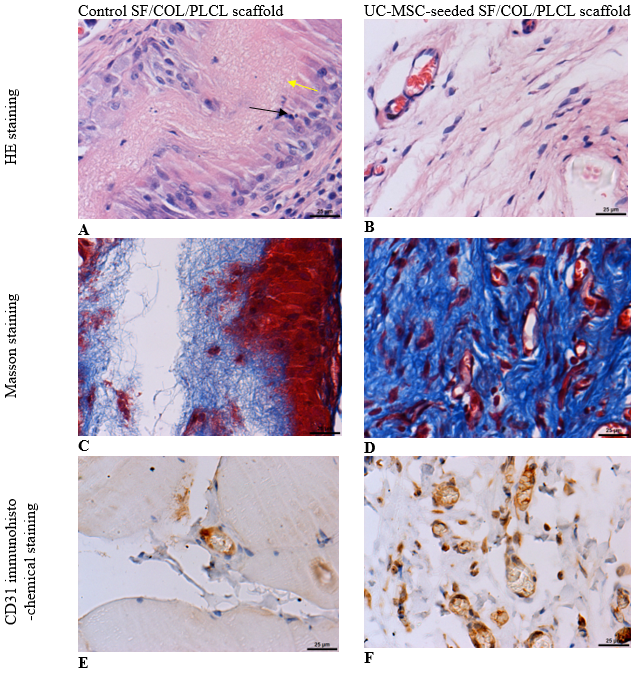
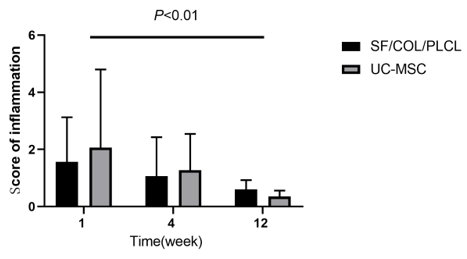
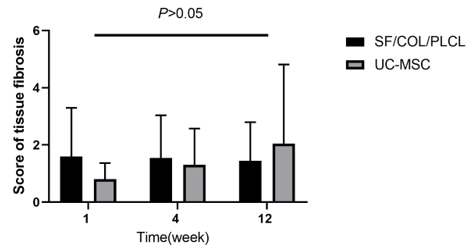
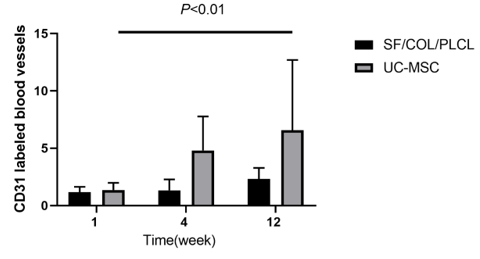
The Masson and immunohistochemistry staining revealed that the UC-MSC-seeded scaffold group exhibited enhanced integration into rat tissues; the scaffolds had been completely degraded and they had been replaced by soft tissues, with evidence of extensive angiogenesis, based on the presence of CD-31-labelled blood vessels. The naked SF/COL/PLCL group had integrated poorly into the rat tissue, and the scaffold could still be seen by week 12. Comparing the naked SF/COL/PLCL nano-fibrous membrane with the UCMSC seeded nano-fibrous membrane, it was clear that the seeded scaffold exhibited significantly more CD-31-labelled blood vessels (F=81.75, p less than 0.01 fibration score, between the two groups, had lower statistical significance (F=2.40, p>0.05; Figure 2, 3).
4.4. IL-2, IL-6, IL-8 and TNF-α levels tested by qRT-PCR
The relative levels of IL-2, IL-6, IL-8, and TNF-α in the surrounding tissue of the implant scaffold showed a general decreasing trend as time passed. Compared to the control SF/COL/PLCL scaffold, the UC-MSC-seeded scaffold had mildly elevated levels of IL-6, IL-8, and TNF-α in the surrounding tissue at 1 and 4 weeks post-implantation. There was no significant difference in the expression levels of IL-2, IL-8, and TNF-α between the two groups at each time point (p>0.05). However, the difference in IL-6 levels between groups was statistically significant (p less than 0.05), and it was more obvious at 12 weeks (P less than 0.01; Figure 5).
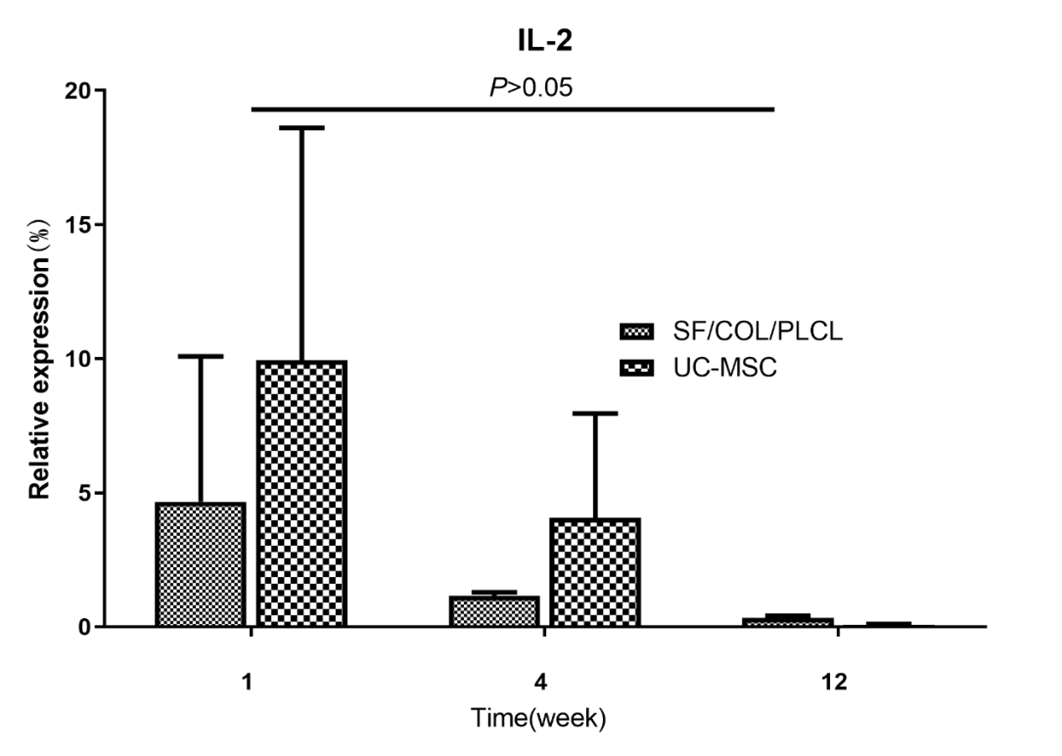
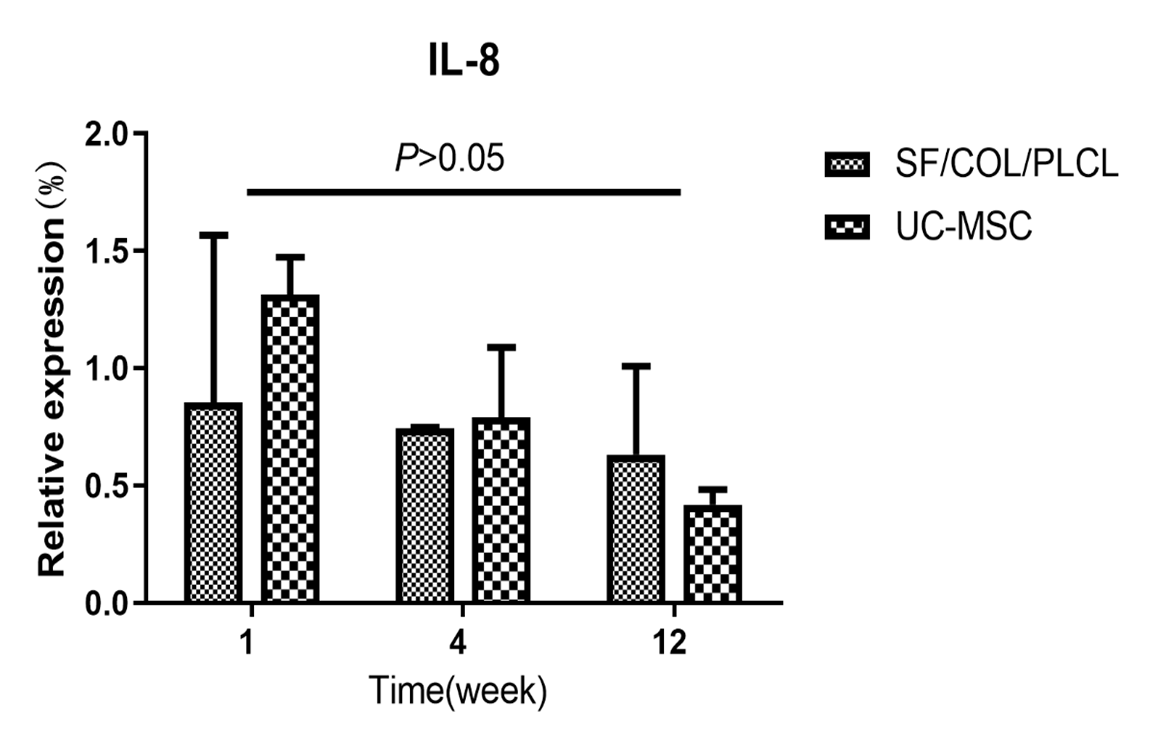
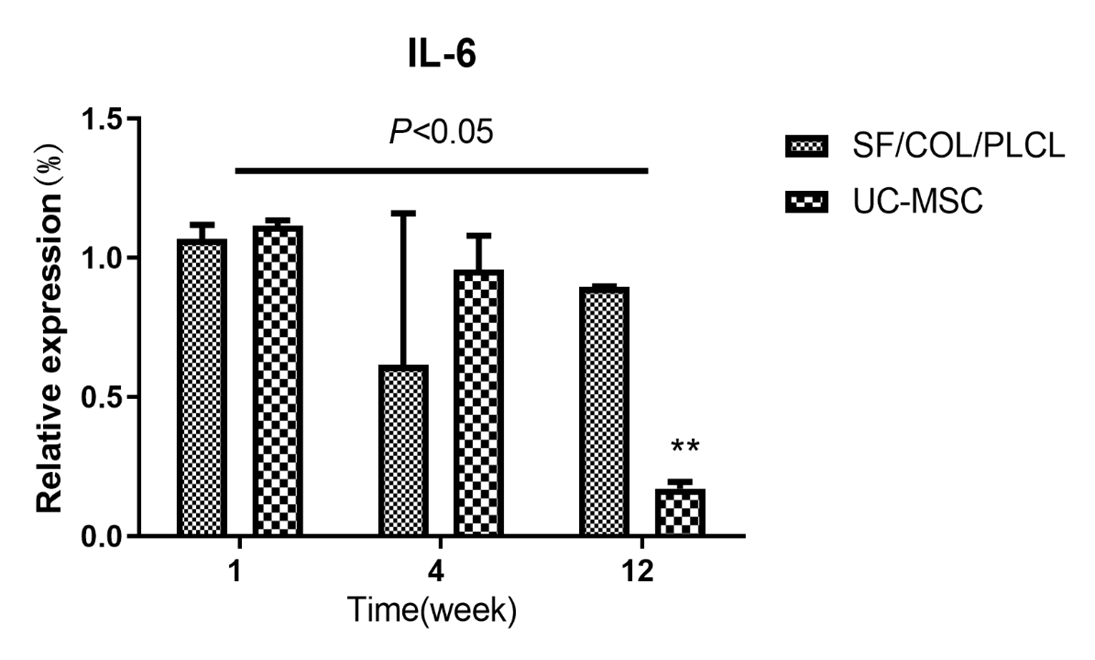
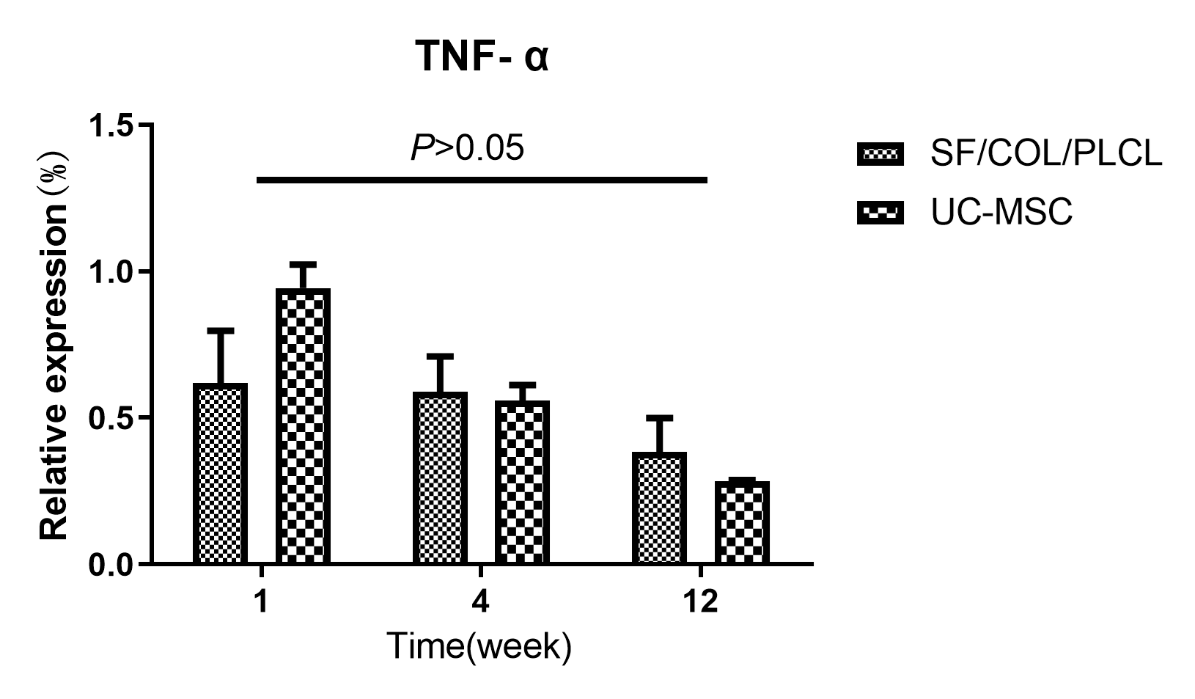
This study demonstrated that UC-MSCs grew well after inoculation onto nanofibrous scaffolds in vitro, and that cell numbers reached their maximum after 7 days. The cell morphology and extension were normal, indicating that the SF/COL/PLCL electrospun nanofibre scaffold was cell compatible.
When biomaterials are implanted in the body, they often trigger an inflammatory response immediately. An excessive inflammatory response not only leads to local tissue swelling and necrosis but also causes extensive fibrosis. When this occurs in the case of pelvic floor reconstruction, the implanted mesh often deforms and shrinks, resulting in increased stiffness in the local tissue. Our results showed that the SF/COL/PLCL patches seeded with UC-MSCs had a better histological score than the naked patch, despite an increase in infiltration by inflammatory cells in the tissue after 1 week. The improvement is more than likely facilitated by the rapid degradation of the implanted mesh, since we observed that by the end of the 12th week of study, the implanted patches seeded with UC-MSCs had completely degraded. This observation, along with the increase in the number of collagen fibres and evidence of extensive neovascularization, led us to speculate that this type of implanted mesh will be beneficial for patients suffering from POP.
This was further evidenced by the observed increases in the levels of inflammatory cytokines IL-6, IL-8, and TNF-α in the early stages post-implantation, which is suggestive of more extensive infiltration by inflammatory cells, potentially induced by the enhanced degradation process, and the resulting absorption of the matrix by the host [23].
The inflammatory response to the seeded nanofibres ended up being a short-term response. By the end of the study, the levels of inflammatory cytokines were lower, suggesting more extensive inflammation resolution. This might be due to the documented [24] immunosuppressive properties of UC-MSCs, which have been attributed to their ability to suppress lymphocyte proliferation [25], along with enhanced degradation of the mesh.
IL-6 is a multifunctional cytokine, and multiple studies [26,28] have shown that IL-6 can directly stimulate angiogenesis, induce sprouting of isolated blood vessels, and impact cell proliferation, but the timing of inflammation is critical for these beneficial effects. Like the response to VEGF, continuous exposure to elevated levels of IL-6 can significantly impede the growth of blood vessels [29]. The fact that there were higher levels of IL-6 early on, but that levels dropped as the study progressed implies that the early inflammatory cytokine response, which ended up being beneficial, effectively promoted angiogenesis [30].
The SF/COL/PLCL patch seeded with UC-MSCs showed enhanced biocompatibility, resulting in a high degree of tissue fusion and reduced inflammation following implantation in rats. This research establishes a theoretical foundation for applying composite mesh structures to human pelvic floor reconstruction.
The authors would like to thank the nurses, clinicians, and management staff of Jinhua Maternal & Child Health Care Hospital. Thanks to Jinhua Food and Drug Inspection and Testing Institute for providing us with animal feeding and model making. Thanks to Jinhua Sdam Stem Cell Biotechnology Co., Ltd. for providing us with stem cells. for their participation in and support for this research.
SF/COL/PLCL - Silk fibroin/collagen/poly(lactide-co-caprolactone)
UC-MSCs - Human umbilical cord-derived mesenchymal stem cells
FPFD - Female pelvic floor dysfunction
POP - Pelvic organ prolapse
Conflict of interest: The authors declare that they have no conflict of interest.
This study was supported by the Basic Public Welfare Research Program of Zhejiang Province (LGF19H040001).
Clearly Auctoresonline and particularly Psychology and Mental Health Care Journal is dedicated to improving health care services for individuals and populations. The editorial boards' ability to efficiently recognize and share the global importance of health literacy with a variety of stakeholders. Auctoresonline publishing platform can be used to facilitate of optimal client-based services and should be added to health care professionals' repertoire of evidence-based health care resources.

Journal of Clinical Cardiology and Cardiovascular Intervention The submission and review process was adequate. However I think that the publication total value should have been enlightened in early fases. Thank you for all.

Journal of Women Health Care and Issues By the present mail, I want to say thank to you and tour colleagues for facilitating my published article. Specially thank you for the peer review process, support from the editorial office. I appreciate positively the quality of your journal.
Journal of Clinical Research and Reports I would be very delighted to submit my testimonial regarding the reviewer board and the editorial office. The reviewer board were accurate and helpful regarding any modifications for my manuscript. And the editorial office were very helpful and supportive in contacting and monitoring with any update and offering help. It was my pleasure to contribute with your promising Journal and I am looking forward for more collaboration.

We would like to thank the Journal of Thoracic Disease and Cardiothoracic Surgery because of the services they provided us for our articles. The peer-review process was done in a very excellent time manner, and the opinions of the reviewers helped us to improve our manuscript further. The editorial office had an outstanding correspondence with us and guided us in many ways. During a hard time of the pandemic that is affecting every one of us tremendously, the editorial office helped us make everything easier for publishing scientific work. Hope for a more scientific relationship with your Journal.

The peer-review process which consisted high quality queries on the paper. I did answer six reviewers’ questions and comments before the paper was accepted. The support from the editorial office is excellent.

Journal of Neuroscience and Neurological Surgery. I had the experience of publishing a research article recently. The whole process was simple from submission to publication. The reviewers made specific and valuable recommendations and corrections that improved the quality of my publication. I strongly recommend this Journal.

Dr. Katarzyna Byczkowska My testimonial covering: "The peer review process is quick and effective. The support from the editorial office is very professional and friendly. Quality of the Clinical Cardiology and Cardiovascular Interventions is scientific and publishes ground-breaking research on cardiology that is useful for other professionals in the field.

Thank you most sincerely, with regard to the support you have given in relation to the reviewing process and the processing of my article entitled "Large Cell Neuroendocrine Carcinoma of The Prostate Gland: A Review and Update" for publication in your esteemed Journal, Journal of Cancer Research and Cellular Therapeutics". The editorial team has been very supportive.

Testimony of Journal of Clinical Otorhinolaryngology: work with your Reviews has been a educational and constructive experience. The editorial office were very helpful and supportive. It was a pleasure to contribute to your Journal.

Dr. Bernard Terkimbi Utoo, I am happy to publish my scientific work in Journal of Women Health Care and Issues (JWHCI). The manuscript submission was seamless and peer review process was top notch. I was amazed that 4 reviewers worked on the manuscript which made it a highly technical, standard and excellent quality paper. I appreciate the format and consideration for the APC as well as the speed of publication. It is my pleasure to continue with this scientific relationship with the esteem JWHCI.

This is an acknowledgment for peer reviewers, editorial board of Journal of Clinical Research and Reports. They show a lot of consideration for us as publishers for our research article “Evaluation of the different factors associated with side effects of COVID-19 vaccination on medical students, Mutah university, Al-Karak, Jordan”, in a very professional and easy way. This journal is one of outstanding medical journal.
Dear Hao Jiang, to Journal of Nutrition and Food Processing We greatly appreciate the efficient, professional and rapid processing of our paper by your team. If there is anything else we should do, please do not hesitate to let us know. On behalf of my co-authors, we would like to express our great appreciation to editor and reviewers.

As an author who has recently published in the journal "Brain and Neurological Disorders". I am delighted to provide a testimonial on the peer review process, editorial office support, and the overall quality of the journal. The peer review process at Brain and Neurological Disorders is rigorous and meticulous, ensuring that only high-quality, evidence-based research is published. The reviewers are experts in their fields, and their comments and suggestions were constructive and helped improve the quality of my manuscript. The review process was timely and efficient, with clear communication from the editorial office at each stage. The support from the editorial office was exceptional throughout the entire process. The editorial staff was responsive, professional, and always willing to help. They provided valuable guidance on formatting, structure, and ethical considerations, making the submission process seamless. Moreover, they kept me informed about the status of my manuscript and provided timely updates, which made the process less stressful. The journal Brain and Neurological Disorders is of the highest quality, with a strong focus on publishing cutting-edge research in the field of neurology. The articles published in this journal are well-researched, rigorously peer-reviewed, and written by experts in the field. The journal maintains high standards, ensuring that readers are provided with the most up-to-date and reliable information on brain and neurological disorders. In conclusion, I had a wonderful experience publishing in Brain and Neurological Disorders. The peer review process was thorough, the editorial office provided exceptional support, and the journal's quality is second to none. I would highly recommend this journal to any researcher working in the field of neurology and brain disorders.

Dear Agrippa Hilda, Journal of Neuroscience and Neurological Surgery, Editorial Coordinator, I trust this message finds you well. I want to extend my appreciation for considering my article for publication in your esteemed journal. I am pleased to provide a testimonial regarding the peer review process and the support received from your editorial office. The peer review process for my paper was carried out in a highly professional and thorough manner. The feedback and comments provided by the authors were constructive and very useful in improving the quality of the manuscript. This rigorous assessment process undoubtedly contributes to the high standards maintained by your journal.

International Journal of Clinical Case Reports and Reviews. I strongly recommend to consider submitting your work to this high-quality journal. The support and availability of the Editorial staff is outstanding and the review process was both efficient and rigorous.

Thank you very much for publishing my Research Article titled “Comparing Treatment Outcome Of Allergic Rhinitis Patients After Using Fluticasone Nasal Spray And Nasal Douching" in the Journal of Clinical Otorhinolaryngology. As Medical Professionals we are immensely benefited from study of various informative Articles and Papers published in this high quality Journal. I look forward to enriching my knowledge by regular study of the Journal and contribute my future work in the field of ENT through the Journal for use by the medical fraternity. The support from the Editorial office was excellent and very prompt. I also welcome the comments received from the readers of my Research Article.

Dear Erica Kelsey, Editorial Coordinator of Cancer Research and Cellular Therapeutics Our team is very satisfied with the processing of our paper by your journal. That was fast, efficient, rigorous, but without unnecessary complications. We appreciated the very short time between the submission of the paper and its publication on line on your site.

I am very glad to say that the peer review process is very successful and fast and support from the Editorial Office. Therefore, I would like to continue our scientific relationship for a long time. And I especially thank you for your kindly attention towards my article. Have a good day!

"We recently published an article entitled “Influence of beta-Cyclodextrins upon the Degradation of Carbofuran Derivatives under Alkaline Conditions" in the Journal of “Pesticides and Biofertilizers” to show that the cyclodextrins protect the carbamates increasing their half-life time in the presence of basic conditions This will be very helpful to understand carbofuran behaviour in the analytical, agro-environmental and food areas. We greatly appreciated the interaction with the editor and the editorial team; we were particularly well accompanied during the course of the revision process, since all various steps towards publication were short and without delay".

I would like to express my gratitude towards you process of article review and submission. I found this to be very fair and expedient. Your follow up has been excellent. I have many publications in national and international journal and your process has been one of the best so far. Keep up the great work.

We are grateful for this opportunity to provide a glowing recommendation to the Journal of Psychiatry and Psychotherapy. We found that the editorial team were very supportive, helpful, kept us abreast of timelines and over all very professional in nature. The peer review process was rigorous, efficient and constructive that really enhanced our article submission. The experience with this journal remains one of our best ever and we look forward to providing future submissions in the near future.

I am very pleased to serve as EBM of the journal, I hope many years of my experience in stem cells can help the journal from one way or another. As we know, stem cells hold great potential for regenerative medicine, which are mostly used to promote the repair response of diseased, dysfunctional or injured tissue using stem cells or their derivatives. I think Stem Cell Research and Therapeutics International is a great platform to publish and share the understanding towards the biology and translational or clinical application of stem cells.

I would like to give my testimony in the support I have got by the peer review process and to support the editorial office where they were of asset to support young author like me to be encouraged to publish their work in your respected journal and globalize and share knowledge across the globe. I really give my great gratitude to your journal and the peer review including the editorial office.

I am delighted to publish our manuscript entitled "A Perspective on Cocaine Induced Stroke - Its Mechanisms and Management" in the Journal of Neuroscience and Neurological Surgery. The peer review process, support from the editorial office, and quality of the journal are excellent. The manuscripts published are of high quality and of excellent scientific value. I recommend this journal very much to colleagues.

Dr.Tania Muñoz, My experience as researcher and author of a review article in The Journal Clinical Cardiology and Interventions has been very enriching and stimulating. The editorial team is excellent, performs its work with absolute responsibility and delivery. They are proactive, dynamic and receptive to all proposals. Supporting at all times the vast universe of authors who choose them as an option for publication. The team of review specialists, members of the editorial board, are brilliant professionals, with remarkable performance in medical research and scientific methodology. Together they form a frontline team that consolidates the JCCI as a magnificent option for the publication and review of high-level medical articles and broad collective interest. I am honored to be able to share my review article and open to receive all your comments.

“The peer review process of JPMHC is quick and effective. Authors are benefited by good and professional reviewers with huge experience in the field of psychology and mental health. The support from the editorial office is very professional. People to contact to are friendly and happy to help and assist any query authors might have. Quality of the Journal is scientific and publishes ground-breaking research on mental health that is useful for other professionals in the field”.

Dear editorial department: On behalf of our team, I hereby certify the reliability and superiority of the International Journal of Clinical Case Reports and Reviews in the peer review process, editorial support, and journal quality. Firstly, the peer review process of the International Journal of Clinical Case Reports and Reviews is rigorous, fair, transparent, fast, and of high quality. The editorial department invites experts from relevant fields as anonymous reviewers to review all submitted manuscripts. These experts have rich academic backgrounds and experience, and can accurately evaluate the academic quality, originality, and suitability of manuscripts. The editorial department is committed to ensuring the rigor of the peer review process, while also making every effort to ensure a fast review cycle to meet the needs of authors and the academic community. Secondly, the editorial team of the International Journal of Clinical Case Reports and Reviews is composed of a group of senior scholars and professionals with rich experience and professional knowledge in related fields. The editorial department is committed to assisting authors in improving their manuscripts, ensuring their academic accuracy, clarity, and completeness. Editors actively collaborate with authors, providing useful suggestions and feedback to promote the improvement and development of the manuscript. We believe that the support of the editorial department is one of the key factors in ensuring the quality of the journal. Finally, the International Journal of Clinical Case Reports and Reviews is renowned for its high- quality articles and strict academic standards. The editorial department is committed to publishing innovative and academically valuable research results to promote the development and progress of related fields. The International Journal of Clinical Case Reports and Reviews is reasonably priced and ensures excellent service and quality ratio, allowing authors to obtain high-level academic publishing opportunities in an affordable manner. I hereby solemnly declare that the International Journal of Clinical Case Reports and Reviews has a high level of credibility and superiority in terms of peer review process, editorial support, reasonable fees, and journal quality. Sincerely, Rui Tao.

Clinical Cardiology and Cardiovascular Interventions I testity the covering of the peer review process, support from the editorial office, and quality of the journal.

Clinical Cardiology and Cardiovascular Interventions, we deeply appreciate the interest shown in our work and its publication. It has been a true pleasure to collaborate with you. The peer review process, as well as the support provided by the editorial office, have been exceptional, and the quality of the journal is very high, which was a determining factor in our decision to publish with you.
The peer reviewers process is quick and effective, the supports from editorial office is excellent, the quality of journal is high. I would like to collabroate with Internatioanl journal of Clinical Case Reports and Reviews journal clinically in the future time.

Clinical Cardiology and Cardiovascular Interventions, I would like to express my sincerest gratitude for the trust placed in our team for the publication in your journal. It has been a true pleasure to collaborate with you on this project. I am pleased to inform you that both the peer review process and the attention from the editorial coordination have been excellent. Your team has worked with dedication and professionalism to ensure that your publication meets the highest standards of quality. We are confident that this collaboration will result in mutual success, and we are eager to see the fruits of this shared effort.

Dear Dr. Jessica Magne, Editorial Coordinator 0f Clinical Cardiology and Cardiovascular Interventions, I hope this message finds you well. I want to express my utmost gratitude for your excellent work and for the dedication and speed in the publication process of my article titled "Navigating Innovation: Qualitative Insights on Using Technology for Health Education in Acute Coronary Syndrome Patients." I am very satisfied with the peer review process, the support from the editorial office, and the quality of the journal. I hope we can maintain our scientific relationship in the long term.
Dear Monica Gissare, - Editorial Coordinator of Nutrition and Food Processing. ¨My testimony with you is truly professional, with a positive response regarding the follow-up of the article and its review, you took into account my qualities and the importance of the topic¨.

Dear Dr. Jessica Magne, Editorial Coordinator 0f Clinical Cardiology and Cardiovascular Interventions, The review process for the article “The Handling of Anti-aggregants and Anticoagulants in the Oncologic Heart Patient Submitted to Surgery” was extremely rigorous and detailed. From the initial submission to the final acceptance, the editorial team at the “Journal of Clinical Cardiology and Cardiovascular Interventions” demonstrated a high level of professionalism and dedication. The reviewers provided constructive and detailed feedback, which was essential for improving the quality of our work. Communication was always clear and efficient, ensuring that all our questions were promptly addressed. The quality of the “Journal of Clinical Cardiology and Cardiovascular Interventions” is undeniable. It is a peer-reviewed, open-access publication dedicated exclusively to disseminating high-quality research in the field of clinical cardiology and cardiovascular interventions. The journal's impact factor is currently under evaluation, and it is indexed in reputable databases, which further reinforces its credibility and relevance in the scientific field. I highly recommend this journal to researchers looking for a reputable platform to publish their studies.

Dear Editorial Coordinator of the Journal of Nutrition and Food Processing! "I would like to thank the Journal of Nutrition and Food Processing for including and publishing my article. The peer review process was very quick, movement and precise. The Editorial Board has done an extremely conscientious job with much help, valuable comments and advices. I find the journal very valuable from a professional point of view, thank you very much for allowing me to be part of it and I would like to participate in the future!”

Dealing with The Journal of Neurology and Neurological Surgery was very smooth and comprehensive. The office staff took time to address my needs and the response from editors and the office was prompt and fair. I certainly hope to publish with this journal again.Their professionalism is apparent and more than satisfactory. Susan Weiner

My Testimonial Covering as fellowing: Lin-Show Chin. The peer reviewers process is quick and effective, the supports from editorial office is excellent, the quality of journal is high. I would like to collabroate with Internatioanl journal of Clinical Case Reports and Reviews.

My experience publishing in Psychology and Mental Health Care was exceptional. The peer review process was rigorous and constructive, with reviewers providing valuable insights that helped enhance the quality of our work. The editorial team was highly supportive and responsive, making the submission process smooth and efficient. The journal's commitment to high standards and academic rigor makes it a respected platform for quality research. I am grateful for the opportunity to publish in such a reputable journal.
My experience publishing in International Journal of Clinical Case Reports and Reviews was exceptional. I Come forth to Provide a Testimonial Covering the Peer Review Process and the editorial office for the Professional and Impartial Evaluation of the Manuscript.

I would like to offer my testimony in the support. I have received through the peer review process and support the editorial office where they are to support young authors like me, encourage them to publish their work in your esteemed journals, and globalize and share knowledge globally. I really appreciate your journal, peer review, and editorial office.
Dear Agrippa Hilda- Editorial Coordinator of Journal of Neuroscience and Neurological Surgery, "The peer review process was very quick and of high quality, which can also be seen in the articles in the journal. The collaboration with the editorial office was very good."

I would like to express my sincere gratitude for the support and efficiency provided by the editorial office throughout the publication process of my article, “Delayed Vulvar Metastases from Rectal Carcinoma: A Case Report.” I greatly appreciate the assistance and guidance I received from your team, which made the entire process smooth and efficient. The peer review process was thorough and constructive, contributing to the overall quality of the final article. I am very grateful for the high level of professionalism and commitment shown by the editorial staff, and I look forward to maintaining a long-term collaboration with the International Journal of Clinical Case Reports and Reviews.
To Dear Erin Aust, I would like to express my heartfelt appreciation for the opportunity to have my work published in this esteemed journal. The entire publication process was smooth and well-organized, and I am extremely satisfied with the final result. The Editorial Team demonstrated the utmost professionalism, providing prompt and insightful feedback throughout the review process. Their clear communication and constructive suggestions were invaluable in enhancing my manuscript, and their meticulous attention to detail and dedication to quality are truly commendable. Additionally, the support from the Editorial Office was exceptional. From the initial submission to the final publication, I was guided through every step of the process with great care and professionalism. The team's responsiveness and assistance made the entire experience both easy and stress-free. I am also deeply impressed by the quality and reputation of the journal. It is an honor to have my research featured in such a respected publication, and I am confident that it will make a meaningful contribution to the field.

"I am grateful for the opportunity of contributing to [International Journal of Clinical Case Reports and Reviews] and for the rigorous review process that enhances the quality of research published in your esteemed journal. I sincerely appreciate the time and effort of your team who have dedicatedly helped me in improvising changes and modifying my manuscript. The insightful comments and constructive feedback provided have been invaluable in refining and strengthening my work".

I thank the ‘Journal of Clinical Research and Reports’ for accepting this article for publication. This is a rigorously peer reviewed journal which is on all major global scientific data bases. I note the review process was prompt, thorough and professionally critical. It gave us an insight into a number of important scientific/statistical issues. The review prompted us to review the relevant literature again and look at the limitations of the study. The peer reviewers were open, clear in the instructions and the editorial team was very prompt in their communication. This journal certainly publishes quality research articles. I would recommend the journal for any future publications.

Dear Jessica Magne, with gratitude for the joint work. Fast process of receiving and processing the submitted scientific materials in “Clinical Cardiology and Cardiovascular Interventions”. High level of competence of the editors with clear and correct recommendations and ideas for enriching the article.

We found the peer review process quick and positive in its input. The support from the editorial officer has been very agile, always with the intention of improving the article and taking into account our subsequent corrections.

My article, titled 'No Way Out of the Smartphone Epidemic Without Considering the Insights of Brain Research,' has been republished in the International Journal of Clinical Case Reports and Reviews. The review process was seamless and professional, with the editors being both friendly and supportive. I am deeply grateful for their efforts.
To Dear Erin Aust – Editorial Coordinator of Journal of General Medicine and Clinical Practice! I declare that I am absolutely satisfied with your work carried out with great competence in following the manuscript during the various stages from its receipt, during the revision process to the final acceptance for publication. Thank Prof. Elvira Farina

Dear Jessica, and the super professional team of the ‘Clinical Cardiology and Cardiovascular Interventions’ I am sincerely grateful to the coordinated work of the journal team for the no problem with the submission of my manuscript: “Cardiometabolic Disorders in A Pregnant Woman with Severe Preeclampsia on the Background of Morbid Obesity (Case Report).” The review process by 5 experts was fast, and the comments were professional, which made it more specific and academic, and the process of publication and presentation of the article was excellent. I recommend that my colleagues publish articles in this journal, and I am interested in further scientific cooperation. Sincerely and best wishes, Dr. Oleg Golyanovskiy.

Dear Ashley Rosa, Editorial Coordinator of the journal - Psychology and Mental Health Care. " The process of obtaining publication of my article in the Psychology and Mental Health Journal was positive in all areas. The peer review process resulted in a number of valuable comments, the editorial process was collaborative and timely, and the quality of this journal has been quickly noticed, resulting in alternative journals contacting me to publish with them." Warm regards, Susan Anne Smith, PhD. Australian Breastfeeding Association.

Dear Jessica Magne, Editorial Coordinator, Clinical Cardiology and Cardiovascular Interventions, Auctores Publishing LLC. I appreciate the journal (JCCI) editorial office support, the entire team leads were always ready to help, not only on technical front but also on thorough process. Also, I should thank dear reviewers’ attention to detail and creative approach to teach me and bring new insights by their comments. Surely, more discussions and introduction of other hemodynamic devices would provide better prevention and management of shock states. Your efforts and dedication in presenting educational materials in this journal are commendable. Best wishes from, Farahnaz Fallahian.
Dear Maria Emerson, Editorial Coordinator, International Journal of Clinical Case Reports and Reviews, Auctores Publishing LLC. I am delighted to have published our manuscript, "Acute Colonic Pseudo-Obstruction (ACPO): A rare but serious complication following caesarean section." I want to thank the editorial team, especially Maria Emerson, for their prompt review of the manuscript, quick responses to queries, and overall support. Yours sincerely Dr. Victor Olagundoye.

Dear Ashley Rosa, Editorial Coordinator, International Journal of Clinical Case Reports and Reviews. Many thanks for publishing this manuscript after I lost confidence the editors were most helpful, more than other journals Best wishes from, Susan Anne Smith, PhD. Australian Breastfeeding Association.

Dear Agrippa Hilda, Editorial Coordinator, Journal of Neuroscience and Neurological Surgery. The entire process including article submission, review, revision, and publication was extremely easy. The journal editor was prompt and helpful, and the reviewers contributed to the quality of the paper. Thank you so much! Eric Nussbaum, MD
Dr Hala Al Shaikh This is to acknowledge that the peer review process for the article ’ A Novel Gnrh1 Gene Mutation in Four Omani Male Siblings, Presentation and Management ’ sent to the International Journal of Clinical Case Reports and Reviews was quick and smooth. The editorial office was prompt with easy communication.

Dear Erin Aust, Editorial Coordinator, Journal of General Medicine and Clinical Practice. We are pleased to share our experience with the “Journal of General Medicine and Clinical Practice”, following the successful publication of our article. The peer review process was thorough and constructive, helping to improve the clarity and quality of the manuscript. We are especially thankful to Ms. Erin Aust, the Editorial Coordinator, for her prompt communication and continuous support throughout the process. Her professionalism ensured a smooth and efficient publication experience. The journal upholds high editorial standards, and we highly recommend it to fellow researchers seeking a credible platform for their work. Best wishes By, Dr. Rakhi Mishra.

Dear Jessica Magne, Editorial Coordinator, Clinical Cardiology and Cardiovascular Interventions, Auctores Publishing LLC. The peer review process of the journal of Clinical Cardiology and Cardiovascular Interventions was excellent and fast, as was the support of the editorial office and the quality of the journal. Kind regards Walter F. Riesen Prof. Dr. Dr. h.c. Walter F. Riesen.

Dear Ashley Rosa, Editorial Coordinator, International Journal of Clinical Case Reports and Reviews, Auctores Publishing LLC. Thank you for publishing our article, Exploring Clozapine's Efficacy in Managing Aggression: A Multiple Single-Case Study in Forensic Psychiatry in the international journal of clinical case reports and reviews. We found the peer review process very professional and efficient. The comments were constructive, and the whole process was efficient. On behalf of the co-authors, I would like to thank you for publishing this article. With regards, Dr. Jelle R. Lettinga.

Dear Clarissa Eric, Editorial Coordinator, Journal of Clinical Case Reports and Studies, I would like to express my deep admiration for the exceptional professionalism demonstrated by your journal. I am thoroughly impressed by the speed of the editorial process, the substantive and insightful reviews, and the meticulous preparation of the manuscript for publication. Additionally, I greatly appreciate the courteous and immediate responses from your editorial office to all my inquiries. Best Regards, Dariusz Ziora

Dear Chrystine Mejia, Editorial Coordinator, Journal of Neurodegeneration and Neurorehabilitation, Auctores Publishing LLC, We would like to thank the editorial team for the smooth and high-quality communication leading up to the publication of our article in the Journal of Neurodegeneration and Neurorehabilitation. The reviewers have extensive knowledge in the field, and their relevant questions helped to add value to our publication. Kind regards, Dr. Ravi Shrivastava.

Dear Clarissa Eric, Editorial Coordinator, Journal of Clinical Case Reports and Studies, Auctores Publishing LLC, USA Office: +1-(302)-520-2644. I would like to express my sincere appreciation for the efficient and professional handling of my case report by the ‘Journal of Clinical Case Reports and Studies’. The peer review process was not only fast but also highly constructive—the reviewers’ comments were clear, relevant, and greatly helped me improve the quality and clarity of my manuscript. I also received excellent support from the editorial office throughout the process. Communication was smooth and timely, and I felt well guided at every stage, from submission to publication. The overall quality and rigor of the journal are truly commendable. I am pleased to have published my work with Journal of Clinical Case Reports and Studies, and I look forward to future opportunities for collaboration. Sincerely, Aline Tollet, UCLouvain.

Dear Ms. Mayra Duenas, Editorial Coordinator, International Journal of Clinical Case Reports and Reviews. “The International Journal of Clinical Case Reports and Reviews represented the “ideal house” to share with the research community a first experience with the use of the Simeox device for speech rehabilitation. High scientific reputation and attractive website communication were first determinants for the selection of this Journal, and the following submission process exceeded expectations: fast but highly professional peer review, great support by the editorial office, elegant graphic layout. Exactly what a dynamic research team - also composed by allied professionals - needs!" From, Chiara Beccaluva, PT - Italy.

Dear Maria Emerson, Editorial Coordinator, we have deeply appreciated the professionalism demonstrated by the International Journal of Clinical Case Reports and Reviews. The reviewers have extensive knowledge of our field and have been very efficient and fast in supporting the process. I am really looking forward to further collaboration. Thanks. Best regards, Dr. Claudio Ligresti